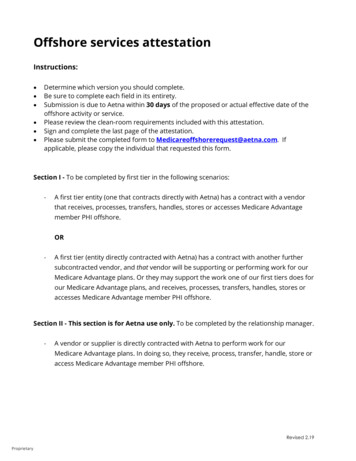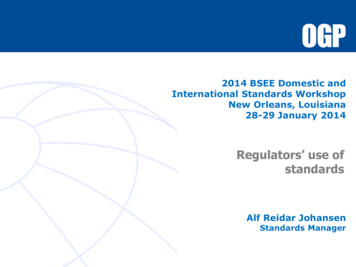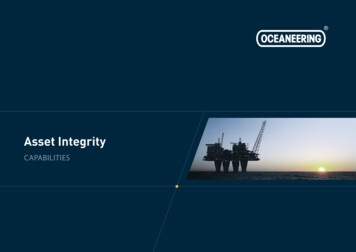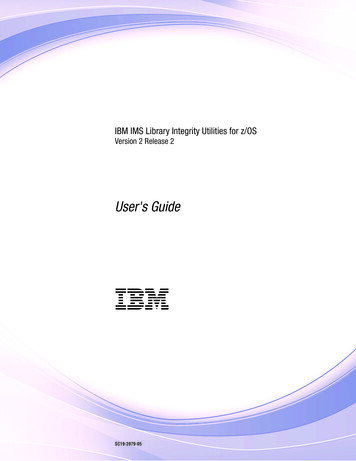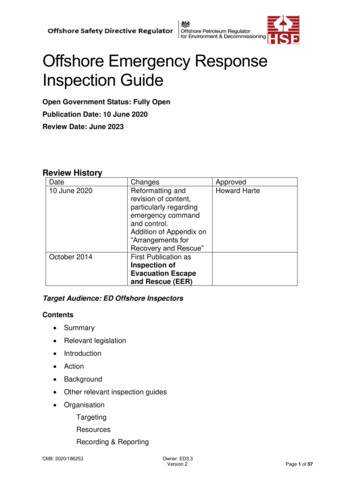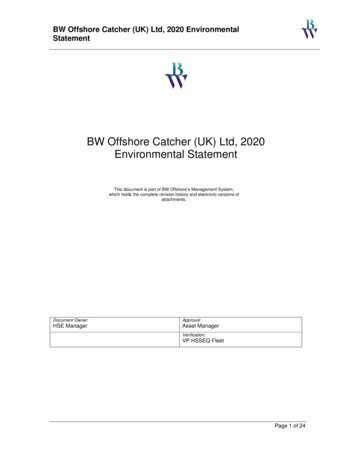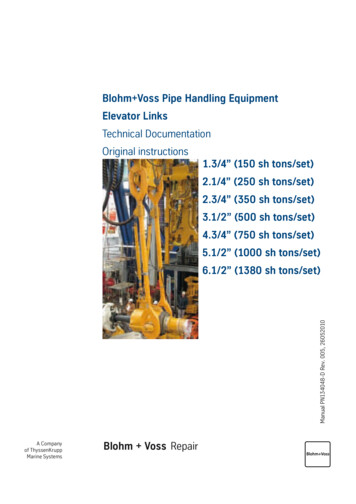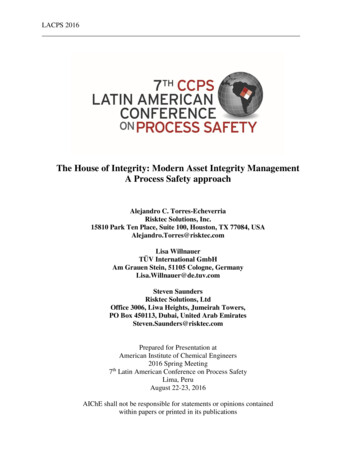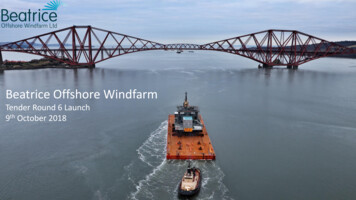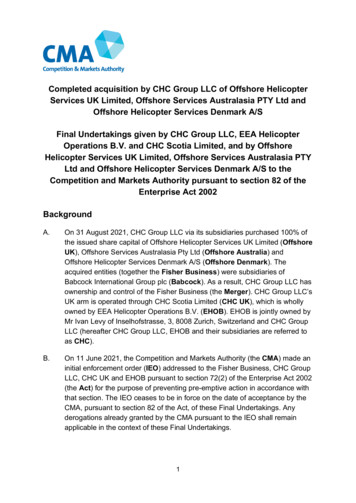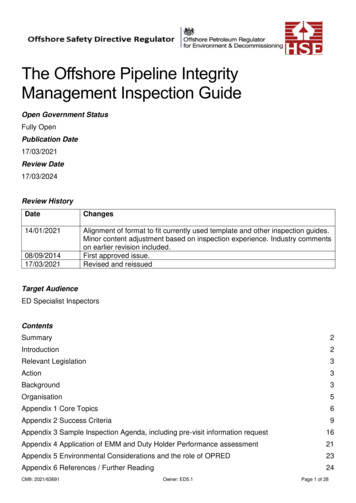
Transcription
The Offshore Pipeline IntegrityManagement Inspection GuideOpen Government StatusFully OpenPublication Date17/03/2021Review Date17/03/2024Review HistoryDateChanges14/01/2021Alignment of format to fit currently used template and other inspection guides.Minor content adjustment based on inspection experience. Industry commentson earlier revision included.First approved issue.Revised and reissued08/09/201417/03/2021Target AudienceED Specialist InspectorsContentsSummary2Introduction2Relevant x 1 Core Topics6Appendix 2 Success Criteria9Appendix 3 Sample Inspection Agenda, including pre-visit information request16Appendix 4 Application of EMM and Duty Holder Performance assessment21Appendix 5 Environmental Considerations and the role of OPRED23Appendix 6 References / Further Reading24CM9: 2021/63691Owner: ED5.1Page 1 of 28
SummaryThis inspection guide (IG) outlines the approach to the inspection of duty holder’s arrangementswith respect to offshore pipeline integrity management, and the key areas that inspectors shouldconsider when inspecting this topic. It describes the four core inspection topics and sets thecriteria for satisfactory and unsatisfactory performance factors against which duty holderperformance will be rated. References are made to technical standards and guidance thatinspectors will use to form an opinion of legal compliance. It provides a consistent framework forjudging compliance, assigning performance ratings and determining follow up actions.IntroductionThe purpose of this IG is to provide information and guidance to inspectors to support the deliveryof consistent and effective inspection of duty holder arrangements to comply with offshore pipelineintegrity management.This IG highlights key areas for inspection and provides a framework against which inspectors canjudge compliance, assign performance ratings, and determine what enforcement action should betaken with respect to legislative breaches that may be found.For offshore pipeline systems transporting hydrocarbons, the consequences of poor integritymanagement, yielding in hydrocarbon releases (HCRs), have the potential to be catastrophic forthe resident workforce on offshore installations and other users of the sea.A principal aim in HSE’s Sector Plan for Offshore Energy is to ensure that the integrity of offshoreinstallations, wells, well control equipment and pipelines are ensured throughout their life cycle, inorder to prevent HCRs and major hazard incidents. Targeted inspections based on this operationalguidance will support HSE’s strategy by systematically evaluating the adequacy of pipeline operators' arrangements for pipelineintegrity management against a consistent set of criteria; and ensuring that appropriate enforcement action is taken in cases where legal minimumstandards are not metThe core topics, covered by an offshore pipeline integrity management inspection, are as follows pipeline design compliance and the identification and assessment of integrity managementarrangements pipeline safety management system (SMS) implementation of the pipeline integrity management process emergency planning and preparednessCM9: 2021/63691Owner: ED5.1Page 2 of 28
Relevant LegislationRelevant legislation and a summary of relevant key requirements is provided in Appendix 6.ActionInspectors should review relevant documentation, see Appendix 3 for details on Pre-visitInformation Request, prior to the installation visit and test compliance during the installation visitagainst the “success criteria” given in Appendix 2.Prior to undertaking inspections, inspectors should prepare inspection agendas. These agendas,covering both the onshore and offshore part of the inspection, should follow the example given inAppendix 3, amended as appropriate. All four topic areas may not be included during eachinspection.During offshore pipeline integrity management inspections, inspectors should compare standards of performance for the four core topics, see Appendix 1, against therelevant success criteria, see Appendix 2 use performance descriptors, see Appendix 4, to determine the appropriate performancerating and initial enforcement expectation consider how and when any issues raised during the inspection are to be closed out, makinguse of the COIN issues tab, and taking formal enforcement action where appropriateBackgroundPipelines can be subject to a range of degradation mechanisms, e.g. corrosion, erosion, andembrittlement. This progressive deterioration is known as ageing. The issue of pipeline ageing andintegrity is particularly significant for the UK offshore oil and gas industry because manyhydrocarbon pipelines within the United Kingdom Continental Shelf (UKCS) are over 30 yearsold. Oil and gas supplies continue to be sourced from existing UKCS infrastructure and viainterconnector pipelines from Europe. These pipelines may need to operate for many more yearsto meet UK energy demands. It is vital that these pipelines, some of which exceed their originaldesign life, continue to operate with minimal risk to people, the environment and the security of theUK's energy supplies.Pipelines can also fail through damage mechanisms that are not age-related, e.g. dropped objectdamage, trawl gear interaction or accidental overpressure.In order to comply with their legal duties, pipeline operators need to identify, assess, and properlycontrol significant potential threats to their pipelines. They should also make appropriate use ofCM9: 2021/63691Owner: ED5.1Page 3 of 28
technical advances (e.g. in inspection technology; defect assessment and repair methods), toensure that the risk of pipeline failure continues to be as low as reasonably practicable (ALARP).Poor subsea pipeline integrity management also poses risks to the environment.The Offshore Petroleum Regulator for Environment and Decommissioning (OPRED), which sitswithin the Department for Business, Energy and Industrial Strategy (BEIS), is responsible forenvironmental matters and HSE and OPRED operate under a memorandum of understanding(MOU) to effectively co-ordinate their regulatory activity on the UKCS. Under the MOU, HSE andOPRED may share relevant information following inspections or investigations. This may includeaspects associated with pipeline ageing and integrity where UKCS pipeline infrastructure orsecurity of supply may be compromised.Linked with ageing pipeline and infrastructure is decommissioning which is another challenge forNorth Sea operators. A decommissioning programme is initiated by the operator some time beforethe end of life is reached, and this must be approved by OPRED and the Oil and Gas Authority(OGA) before the system can be shut in and decommissioning commenced. OPRED consult HSEin this process. The operator is required to look at a number of possible approaches todecommissioning and carry out a comparative assessment (CA) of the main options in order toarrive at the preferred decommissioning programme. Consideration will be given to leavingpipelines in situ if they are buried, or the requirement to remove to leave a clear seabed.Consideration needs to be given to the environment and the safety of other users of the sea.Notification under Pipeline Safety Regulations 1996 (PSR) Regulation 22(2) will be required withthe possibility of a material change to the safety case under the Offshore Installations (OffshoreSafety Directive) (Safety Case etc.) Regulations 2015 (SCR2015) Regulation 24 prior to thesubmission of a dismantling safety case under SCR2015 Regulation 20.OPRED also manage the interim pipeline regime (IPR) which allows operators to enter pipelineswhich are no longer required for production but where the field decommissioning programme hasnot yet commenced. OPRED also consult HSE in this process. The IPR is intended to ensure ‘outof use’ pipelines do not pose a risk to other users of the sea or the environment and, during thisperiod, they must be covered by an appropriate survey and maintenance regime from the pointwhen they are taken out of use until approval of the formal decommissioning programme, which isusually at the end of field life. Any interim solution should not prejudice the final decommissioningoptions for that line, including complete removal.Appendix 5 gives further details about environmental considerations and the role of OPRED.Appendix 6 gives further information about relevant legislation and provides references totechnical standards and other useful resources.CM9: 2021/63691Owner: ED5.1Page 4 of 28
OrganisationTargetingPipeline integrity management is a strategic priority topic and inspections should be included inHSE Energy Division’s (ED) Offshore Intervention Plans (IPs). Where other topics have beenidentified as local priorities, inspectors should take this into consideration when preparing their IPs.ED5's risk ranking arrangements should also be used to assist inspectors when determiningintervention frequencies and targeting.TimingInspectors should undertake offshore pipeline integrity management inspections as part of theagreed ED Offshore Intervention Plan; when intelligence indicates intervention is necessary, or aspart of an investigation following an incident.ResourcesResource for the undertaking of offshore pipeline integrity management interventions will beagreed as part of the ED Offshore Work Plan or by agreement between discipline specialist teamleaders and inspection management team-leaders, as appropriate.Recording and ReportingThe duty holder performance ratings should be entered on the Inspection Rating (IRF) Tab of therelevant installation Intervention Plan Service Order. Findings should be recorded in the postinspection report and letter.Appendix 1 describes the four core topics and Appendix 2 describes the associated successcriteria that inspectors should consider during inspections of offshore pipeline integritymanagement. Not all of the success criteria will apply in every case and inspectors should onlyconsider those that are relevant at each inspection. If any success criteria are not met, inspectorsshould assess how serious the consequences could be using HSE’s Enforcement ManagementModel. This will determine the performance ratings that they should assign and the enforcementaction to be taken, if any.CM9: 2021/63691Owner: ED5.1Page 5 of 28
Appendix 1 Core TopicsPipeline design compliance and the identification and assessment of integrity managementarrangementsThe design of the pipeline and any modifications to it must take into account the operating regime,the fluid to be conveyed and the external environment. Pipeline design is also the starting point forinspection, testing and maintenance, for example the pipeline design determines the ease withwhich it can be pigged, or pressure tested.Another key design consideration is the pipeline's safety features. For instance the location, in which a riser emergency shut down valve (ESDV) is installed, is critical inisolating the pipeline and riser inventory from the effects of riser damage at as many aspossible inboard (of the ESDV) locations the installation and operation of a subsea isolation valve (SSIV) reduces the severity of theconsequences of a riser failure outboard of or below the riser ESDVThis inspection topic is not only relevant for new pipeline construction. Retrospective inspection ofthe design of existing pipelines can provide important information on how integrity managementarrangements relate to the original design. For example, if evidence is found that the pipeline isbeing operated outside of its original design parameters, this may cast doubt on the assumptionsthat underpin the integrity management arrangements going forward.Any design life extension should contain detailed safety evaluation, including systematicconsideration of ageing effects, and demonstration of continued safe operation. For instance evidence of risk-based design life extension process or formal design life extensionassessment being implemented before pipeline reaches end of design life the assessment includes a review of the design premise of pipeline including a review ofconstruction and operational history use of risk assessment as part of design life extension process to identify new threats topipeline as a consequence of ageing and any additional measures required to control therisk consideration to all parts of the pipeline system e.g. valves, pig traps, control systems, asper PSR Regulation 3 evidence that condition monitoring assessments and modelling as part of design lifeextension work are backed up by inspection e.g. in-line inspection (ILI) or NDT atrepresentative sample locations, particularly where there are gaps in process andoperational data during service life of pipelineCM9: 2021/63691Owner: ED5.1Page 6 of 28
it is recognised that degradation mechanisms and failure modes for unbonded flexibles areinherently complex, so evidence is required that personnel with sufficient competence inflexibles have been involved in the detailed safety evaluationPipeline safety management system (SMS)For major accident hazard pipelines (MAHPs), PSR define 'safety management system' (SMS) asthe organisation, arrangements and procedures established by the operator for ensuring that therisk of a major accident is as low as is reasonably practicable (ALARP). The pipeline SMS needsto consider the interfaces between pipeline design, construction, operation and maintenance. Keyelements of the SMS are leadership, commitment, accountability and competence. Both adequateorganisation and sufficient resource are necessary to implement the operator's policy with respectto the effective control of major accident hazards.Traditional SMSs tend to focus on occupational health and safety and are unlikely to be fit forpurpose for delivering safe pipeline operations. The major accident prevention document (MAPD)required by PSR for MAHPs must demonstrate that the pipelines SMS is adequate. This can beverified during inspections.Implementation of the pipeline integrity management processThis topic concerns the ongoing routines, processes and procedures that need to be in place tosuccessfully deliver pipeline integrity. A range of equipment, instruments, devices and techniqueshave been developed for the protection, operation, inspection, testing and maintenance of subseapipelines. Inspectors will expect pipeline operators to consider and, where appropriate, utiliseimproved techniques and technologies.Accidental damage is a continuing risk to the integrity of offshore pipelines, e.g. anchor damage,vessel collisions, dropped objects. Inspectors will expect offshore pipeline operators to take stepsto minimise the risk of accidental damage occurring to their pipelines.Emergency planning and preparednessMAHP incidents can be very serious and warrant a carefully planned and rehearsed multi-agencyemergency response. Planning for emergencies at MAHPs is therefore an explicit requirement ofPSR.PSR requires that the operators of MAHPs prepare adequate emergency procedures for dealingwith the consequences of a major accident involving a pipeline/riser. These procedures need tocover a range of issues, from safe shut down of operations to liaison with emergency respondersCM9: 2021/63691Owner: ED5.1Page 7 of 28
and communication with the media. These procedures must be tested by the pipeline operator toensure that individuals with a role in emergency response are properly prepared to act in a realemergency. Emergency procedures should also be reviewed and if necessary revised in the lightof any lessons learned from tests.CM9: 2021/63691Owner: ED5.1Page 8 of 28
Appendix 2 Success CriteriaCore topicSuccess criteria1. Pipeline designGeneralcompliance and the identification andassessment of integritydamage/deterioration managementarrangementsDesign of the pipeline and support systems meets appropriate standards and takes into account potentialDesign incorporates suitable safety systems to protect against overpressure, damage, over temperature (e.g. inflexible risers) and other hazards Design allows for adequate inspection (In-line inspection (ILI) is considered industry good practice) Checks are made to ensure that pipeline safety features remain effective as specified in the design parameters Any proposal for design life extension contains detailed safety evaluation including systematic consideration ofageing effects and demonstration of continued safe operation. Evidence of risk based design life extensionprocess or formal design life extension assessment being implemented before pipeline reaches end of design life.The assessment includes a review of the design premise of pipeline including a review of construction andoperational history. Use of risk assessment as part of design life extension process to identify new threats topipeline as a consequence of ageing and any additional control measures to be implemented/actions to be taken(e.g. reduction in safe operating limits) to ensure continued safe operation. Evidence that inspection is carried outto validate condition monitoring assessments and modelling.ESDVs and SSIVs ESDVs installed as far down the risers as is reasonably practicable for all MAHPs Consideration given to fitting SSIVs, particularly for gas pipelines and/or pipelines connected into major trunkpipeline systems with large connected inventories. Where a decision has been made not to install an SSIV thena suitable and sufficient risk assessment should be available to support this decision. The decision as to whetherCM9: 2021/63691Owner: ED5.1Page 9 of 28
an SSIV is to be fitted should have been taken based upon an analysis of the potential consequences and risksof a riser and/or pipeline release, and of damage due to escalation from another riser. The risk of the riser ESDVfailing to operate on demand should be considered in the assessment. The cost of an SSIV must be compared tothe far greater cost if one is not fitted but is needed in an emergency.Risers Review of flexible riser annulus venting system design to ensure that annulus is positively vented away and nocommunal venting systems with other risers which could result in back flow of fluids from one riser annulus toanother For risers contained within caissons and I/J tubes, design should consider ongoing management of the caissonand installation of automatic functions such as closure of the riser ESDV (and/or SSIV where fitted) in the eventof riser failure. Design should also consider means for confirming integrity of risers For caissons and I/J tubes containing hydrocarbon risers: The top of the caisson or I/J tube should be sealed andany hydrocarbons accumulating inside the caisson or I/J tube vented off to a safe place on the installation. Theselected sealing should ensure that hydrocarbons are not able to escape from the caisson or I/J tube undetected.The bottom of the caisson or I/J tube should be designed to prevent sea water from going in and out. Where thereis a need to chemically treat water inside a caisson or I/J tube, suitable access for chemical injection should beprovided and maintained Riser design minimises number of small-bore tubing outboard of the ESDV that may be potential failure points Riser ESDV control panels are located as close as reasonably practicable to the riser location Riser ESDV local controls should be clearly labelled and readily accessible in an emergency Design of installation (riser routing) minimises the risk of impact damage to the riserPig traps CM9: 2021/63691Design allows double block isolation to be achieved for key operations, e.g. at pig trapsOwner: ED5.1Page 10 of 28
Bonding of pig trap body and door closure to ensure electrical continuity and prevent sparking Suitable safety systems in place to prevent the closure door from opening before the pig trap has been isolatedand depressurised2. Pipeline SafetyManagement SystemPlan Effective leadership and commitment to continuous improvement in management of major hazard risks Up to date MAPD that identifies risks to pipeline and control measures and describes arrangements, behavioursand systems that exist in practice (NB: only required for MAHPs) Organisational responsibilities documented e.g. via an organogram People with key responsibilities in the SMS understand their role and are resourced to carry it out effectively Competency management system in place Effective communication and co-operation at pipeline operator interfaces Ownership and responsibilities for all lengths of pipeline clearly understood and documented Arrangements in place to ensure that pipeline regulatory notifications are made as required by PSRDo Pipeline operated to an appropriate codes or recommended practices e.g. BS EN 14161 and DNV-RP-F116 Procedures exist for: safe operation of plant; permit to work, management of change and modifications, safeisolation of plant and equipment, selection and control of contractors, non-routine operations Human factors considered and steps taken to minimise the risk of human failureCheck SMS includes process to test and review the performance of the management system and keep senior,management informed regarding safety performance, e.g. via key performance indicators (KPIs) CM9: 2021/63691Accidents/incidents/near misses investigated, lessons learned and shared within the organisationOwner: ED5.1Page 11 of 28
Programme of SMS audits carried outAct Audit findings, KPI data and other information regarding safety performance reported to a senior level and actedupon3. Implementation andmaintenance ofCorrosion management pipeline integritymanagement processSuitable corrosion management programme implemented with suitable monitoring and review, e.g. cathodicprotection, use of inhibitors (internal), coatings, corrosion probes, control of product quality etc. Where cathodic protection is used, it is monitored, and prompt remedial action taken where problems identifiede.g. exhausted sacrificial anodes Steps taken to address risks of corrosion under insulation on topside sections of the risers and ESDVs Inhibitor (corrosion, scale, biocide) injection systems maintained in good working order i.e. topside pumps,injection metering (injecting at required dose) etc.Inspection and Maintenance Evidence that inspection is used to validate condition monitoring assessments and modelling during life of pipeline ILI regarded as the norm but if not used, alternative arrangements in place and feasibility of future ILI considered ILI protocols justified by previous ILI data and degradation assessment Results of ILI feed into remedial action plans Pressure vessel inspections carried out on relevant equipment e.g. pig launchers Flexible pipelines inspected using appropriate techniques, e.g. annulus pressure monitoring/testing Risers subject to suitable inspection/testing/maintenance, including those within caissons and I/J tubes whereintegrity assessment by means other than inspection should be exploredCM9: 2021/63691Owner: ED5.1Page 12 of 28
Effective caisson management i.e. monitoring and sampling of caisson fluids to ensure the environment remainssuitable and does not threaten the integrity of the riser Documented defect assessment and repair policy in place for all deterioration and damage to pipelineESDVs Implementation of a suitable and adequate inspection and maintenance strategy for ESDV and actuators includingall components with the associated system ESDV inspection covers all elements necessary to ensure valve closure, e.g. actuator and hydraulic lines, inaddition to valve assembly itself ESDV performance standards set for closure times and passage rates, ESDVs inspected and tested to thesestandards Riser ESDVs are identified as safety and environmental critical elements (SECEs) in the verification scheme Maximum ESDV leakage rates determined according to the installations ability to safely control the hazard arisingfrom such a leak Any ESDV bypass locked shut in normal operation, adequate controls for unlocking in placeSSIVs SSIVs are identified as safety and environmental critical elements (SECEs) in the verification scheme Implementation of a suitable and adequate inspection and maintenance strategy for SSIVs and associated system SSIV performance standard set for closure times and leakage rate and SSIVS inspected and tested to thesestandards at suitable intervals Maximum SSIV leakage rates to be determined according to the installations ability to safely control and preventescalation of any pipeline incident, outboard of the Riser ESDV on pipeline/riser close to the installationPig traps (where fitted)CM9: 2021/63691Owner: ED5.1Page 13 of 28
Implementation of a suitable and adequate inspection and maintenance strategy for all valves on pigging facilities Pigging operations carried out to suitable written procedure to include purging, proving isolations and use ofinterlocksDamage prevention Pipeline anchor hazards considered and risk controls in place where appropriate Riser and ESDV protected from fire, impact (including vessel impact) and explosion Lifting over pipelines, risers and associated equipment is controlled Spans monitored and remedial action taken where necessaryDecommissioning Adequate systems in place to ensure the safe isolation from live plant, to include prior testing of valves and theongoing monitoring of the effectiveness of the valve’s performance (where applicable) Purging/cleaning of oil and gas pipelines has been undertaken to satisfy environmental requirements Consideration given to adjacent live pipelines in bundles/piggybacks etc. Establish adequate surveying and maintenance regime of pipelines in IPR until approval of the formaldecommissioning programme Ensure pipelines are either dismantled and removed or left in a condition where they will be not become a sourceof danger to people, as per the decommissioning programme and the requirements of PSR Ensure that work done in carrying out the final decommissioning of a pipeline is done in a safe and controlledmannerOther Key operating parameters (e.g. operating pressure and temperature excursions) monitored, logged and actedupon where appropriateCM9: 2021/63691Owner: ED5.1Page 14 of 28
Effective integrity and damage assessment and appraisal process in line with industry good practice Coherent and ongoing mechanism for ensuring effective oversight and decision making in relation to the integritymanagement arrangements Effective management of the verification process associated with pipeline SECEs System in place to conduct suitable investigations into loss of integrity incidents, implement any remedial actionsand track any evidence of recurring root causes4. Emergency planning and preparednessAdequate pipeline emergency procedures detailing organisation and arrangements are in place for dealing withthe consequences of a major accident involving a pipeline Availability of pipeline emergency procedures in control room MAHP emergency plans and procedures tested, reviewed and revised periodically and in the light of lessonslearned from tests. Regulation 8 of the Offshore Installations (Prevention of Fire and Explosion, and EmergencyResponse) Regulations 1995 (PFEER) requires the installation operator to draw up an emergency response planfor the installation, and this should cover the arrangements in place for emergencies which may affect theconnected pipeline Effective emergency communication arrangements in place between installation operator, operators of anyinterconnecting platforms and pipeline operators Competence of key personnel in emergency procedures is assured Adequate consideration of emergency response in control room design e.g. alarm handling Consideration given to how pipeline depressurisation can be achieved safely in an emergency Effective procedures in place to monitor for evidence of loss of integrity/release/spill to sea and respond tominimise safety/environmental impactCM9: 2021/63691Owner: ED5.1Page 15 of 28
Appendix 3 Sample Inspection Agenda, including pre-visit information requestOnshoreDetailed Pipelines Specific Agenda prior to going offshoreThe key issue is to make sure that the duty holder is identifying and managing hazardsarising to/from pipelines to support maintaining safe operations.Records should be provided (preferably electronically) to allow for the followingactivities prior to offshore tripPipeline and Riser Design Number of MAH pipelines Date of commissioning for pipelines and liquids being transported Status of pipelines – operational/IPR/decommissioned Riser configuration, including riser caissons and J-tubes Water depth and pipeline configuration, including bundles Pipeline SECEsRiser ESD valves Review of records for inspection and testing going back for a reasonable period,including seat leakage testing results, trending, and procedure(s) Review of maintenance records for ESDV including actuator and control system Performance standard, selection of closure times and leak rate Written scheme of examination Corrosion under insulation (CUI) inspection resultsSSIVs (as applicable) Review of records for inspection and testing going back for a reasonable period Performance standard, selection of closure times and leak rate Written scheme of examinationHIPPS (as applicable) Review of records for inspection and testing going back for a reasonable period Performance standard Written scheme of examinationPig traps (as applicable) CM9: 2021/63691Review of technical and procedural risk controlsOwner: ED5.1Page 16 of 28
Review of records for inspection and maintenance going back a reasonable period Review of pig launch/receive proceduresP&IDs and PFDs Review of current piping and instrumentation diagrams for each pipeline riser, ESDvalve and pig trap Review of process flow diagrams (or P&IDs) for subsea systems (as applicable)Flexible risers (as appl
The design of the pipeline and any modifications to it must take into account the operating regime, the fluid to be conveyed and the external environment. Pipeline design is also the starting point for inspection, testing and maintenance, for example the pipeline design determines the ease with which it can be pigged, or pressure tested.
